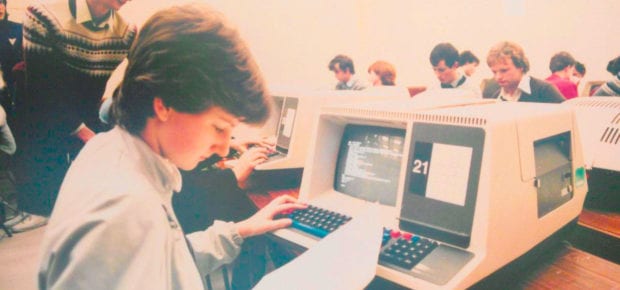July 9, 2015
Education has grown from an industry centered around textbooks to an industry revolving around emerging technologies. Gone are the days when a calculator was the most impressive classroom innovation.
Education has grown from an industry centered around textbooks to an industry revolving around emerging technologies. Gone are the days when a calculator was the most impressive classroom innovation. And while Texas Instruments had us all ogling in our calculus courses with its graphing calculators (oh how we loved our TI-83s), students today have been treated to tech that has evolved to new depths. Educational technology – popularly dubbed “EdTech” – is a big deal. It has revolutionized the way teachers teach, and the way students learn.
EdTech hasn’t always been an ecosystem of computers, tablets and smartphones. In fact, the first real appearance of technology in a classroom is more analog than digital: the radio. In 1920s New York, lesson plans were actually broadcast over radio waves.
Teachers were treated to some instructional technology in the 1930s, including the overhead projector, which was a classroom staple for many decades thereafter.
Before computers made their way into school systems, students were introduced to the not-so-groovy Scantron in the 1970s — a more modern take on the antiquated punchcard, used to improve grading efficiency.
The first computer used for instruction dates all the way back to the 1950s, when MIT used it for flight training, but computers didn’t actually become fixtures in school systems until 1977. Before the days of Google, social media, and digitized news, computers in schools found other ways to bridge education with entertainment — before the days of educators embracing Minecraft, there was Oregon Trail and back in 1985, it was the first known educational computer game used by schools.
Fast forward to the 90s, where mailboxes were overflowing with AOL direct mail trial offers (via the beloved floppy disk and CM-ROM), and higher education institutions were offering expanded distance learning opportunities thanks to a handy tool called the World Wide Web.
Universities were quick to integrate technology into instruction, and grade schools were not far behind. Technologies like the Smart Board, tablets, and even smartphones have now become integral components of the 21st century classroom as instruments for instruction, as well as for study.
With wearables and other forward-thinking innovations in mobile technology and gamification, we’re excited to watch as technology continues to pave a dynamic path for educators and their pupils.





 Liquid Infrastructure: Our Planet's Most Precious Resource
Liquid Infrastructure: Our Planet's Most Precious Resource The Impact of Technology in 2025
The Impact of Technology in 2025 Quantum and AI: Safeguards or Threats to Cybersecurity?
Quantum and AI: Safeguards or Threats to Cybersecurity? Why AI Can't Live Without Us
Why AI Can't Live Without Us Bits, Bytes, Buildings and Bridges: Digital-Driven Infrastructure
Bits, Bytes, Buildings and Bridges: Digital-Driven Infrastructure Impact of Technology in 2024
Impact of Technology in 2024 Emerging AI Cybersecurity Challenges and Solutions
Emerging AI Cybersecurity Challenges and Solutions The Skies are Unlimited
The Skies are Unlimited Smart Cities 2030: How Tech is Reshaping Urbanscapes
Smart Cities 2030: How Tech is Reshaping Urbanscapes Impact of Technology 2023
Impact of Technology 2023 Cybersecurity for Life-Changing Innovations
Cybersecurity for Life-Changing Innovations Smarter Wearables Healthier Life
Smarter Wearables Healthier Life Infrastructure In Motion
Infrastructure In Motion The Impact of Tech in 2022 and Beyond
The Impact of Tech in 2022 and Beyond Cybersecurity, Technology and Protecting Our World
Cybersecurity, Technology and Protecting Our World How Technology Helps us Understand Our Health and Wellness
How Technology Helps us Understand Our Health and Wellness The Resilience of Humanity
The Resilience of Humanity Harnessing and Sustaining our Natural Resources
Harnessing and Sustaining our Natural Resources Creating Healthy Spaces Through Technology
Creating Healthy Spaces Through Technology Exceptional Infrastructure Challenges, Technology and Humanity
Exceptional Infrastructure Challenges, Technology and Humanity The Global Impact of IEEE's 802 Standards
The Global Impact of IEEE's 802 Standards Scenes of our Cyber Lives: The Security Threats and Technology Solutions Protecting Us
Scenes of our Cyber Lives: The Security Threats and Technology Solutions Protecting Us How Millennial Parents are Embracing Health and Wellness Technologies for Their Generation Alpha Kids
How Millennial Parents are Embracing Health and Wellness Technologies for Their Generation Alpha Kids Space Exploration, Technology and Our Lives
Space Exploration, Technology and Our Lives Global Innovation and the Environment
Global Innovation and the Environment How Technology, Privacy and Security are Changing Each Other (And Us)
How Technology, Privacy and Security are Changing Each Other (And Us) Find us in booth 31506, LVCC South Hall 3 and experience the Technology Moon Walk
Find us in booth 31506, LVCC South Hall 3 and experience the Technology Moon Walk Virtual and Mixed Reality
Virtual and Mixed Reality How Robots are Improving our Health
How Robots are Improving our Health IEEE Experts and the Robots They are Teaching
IEEE Experts and the Robots They are Teaching See how millennial parents around the world see AI impacting the lives of their tech-infused offspring
See how millennial parents around the world see AI impacting the lives of their tech-infused offspring Take the journey from farm to table and learn how IoT will help us reach the rising demand for food production
Take the journey from farm to table and learn how IoT will help us reach the rising demand for food production Watch technical experts discuss the latest cyber threats
Watch technical experts discuss the latest cyber threats Explore how researchers, teachers, explorers, healthcare and medical professionals use immersive technologies
Explore how researchers, teachers, explorers, healthcare and medical professionals use immersive technologies Follow the timeline to see how Generation AI will be impacted by technology
Follow the timeline to see how Generation AI will be impacted by technology Learn how your IoT data can be used by experiencing a day in a connected life
Learn how your IoT data can be used by experiencing a day in a connected life Listen to technical experts discuss the biggest security threats today
Listen to technical experts discuss the biggest security threats today See how tech has influenced and evolved with the Games
See how tech has influenced and evolved with the Games Enter our virtual home to explore the IoT (Internet of Things) technologies
Enter our virtual home to explore the IoT (Internet of Things) technologies Explore an interactive map showcasing exciting innovations in robotics
Explore an interactive map showcasing exciting innovations in robotics Interactively explore A.I. in recent Hollywood movies
Interactively explore A.I. in recent Hollywood movies Get immersed in technologies that will improve patients' lives
Get immersed in technologies that will improve patients' lives